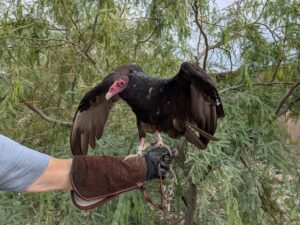Turkey Vulture – Bryce
 Name: Bryce – Male
Name: Bryce – Male
Species: Turkey Vulture
Liberty Arrival: September 2020/ Juvenile
Injury/Condition: Right wing injury
Bryce arrived with his right wing was injured, probably having been hit by a car. Radiographs showed multiple injuries to the wing and their location. The condition of the bone precluded surgery. Once the fractures healed, it was observed that Bryce did not have full wing extension and would not have full flight ability. He was determined to be non-releasable.
Turkey Vulture Facts:
Description: Turkey vultures range as far north as the southern boundary of Canada and south into Central America and South America.
Life span:The average life expectancy of the turkey vulture has been estimated to be from anywhere from 10 to 16 years in the wild. A captive life span of over 30+ years is possible. (Bailey was hatched in 1986.)
Prey: An aerial scavenger, the Turkey Vulture feeds on a wide range of wild and domestic carrion. Dead mammals ranging from mice to cattle are common foods. When carrion is in short supply, the Turkey Vulture has been observed eating plants including rotten pumpkins and coconuts, grapes, and juniper berries.
Babies/Nests: No nest is built. Nesting sites include rock outcrops, fallen trees, cliffs, and hollow logs. Usually, 1 – 3 eggs are laid which hatch in 30 to 40 days. The young fledge in about 70 to 80 days.
Buitre de Pavo – Bryce
Nombre: Bryce – Macho
Especie: Buitre de Pavo
Llegada a Liberty: Septiembre 2020/Joven
Herida/Condición: Herida a su ala derecha
Bryce llego con su ala derecha herida, probablemente por haber sido pegado por un carro. Radiografías enseñaron una variedad de heridas a su ala y donde estaban colocadas. La condición del hueso excluyo la posibilidad de cirugía. Una vez que sus fracturas se curaron, fue observado que Bryce no tenia extensión completa de su ala y que no tenia habilidad completa de poder volar. Determinaron que no podía ser liberado al estado salvaje por estas razones.
Datos del Buitre de Pavo
Descripción: El buitre de pavo puede vivir hasta el norte de la frontera del sur de Canada hasta el sur de Centro América y Sudamérica.
Duración de vida: La duración de vida promedia del buitre de pavo ha sido estimada de ser entre 10 a 16 años en el estado salvaje. En cautiverio la duración de vida puede llegar a ser mas de 30 años.
Presa: Un carroñero aéreo, el buitre de pavo se alimenta con una variedad de carroña salvaje y domestica. Su comida común incluye mamíferos muertos como ratones o vacas. Cuando carroña esta limitada, el buitre de pavo ha sido observada comiendo plantas incluyendo calabaza o cocos podridos, uvas, o bayas de enebro.
Nidos: Los nidos no son construidos, pero ponen sus huevos en afloramiento rocoso, arboles caídos, acantilados, y troncos huecos.
Crías: Típicamente ponen 1 a 3 huevos y salen del huevo en 30 a 40 días. Los jóvenes se van del nido en 70 a 80 días.


